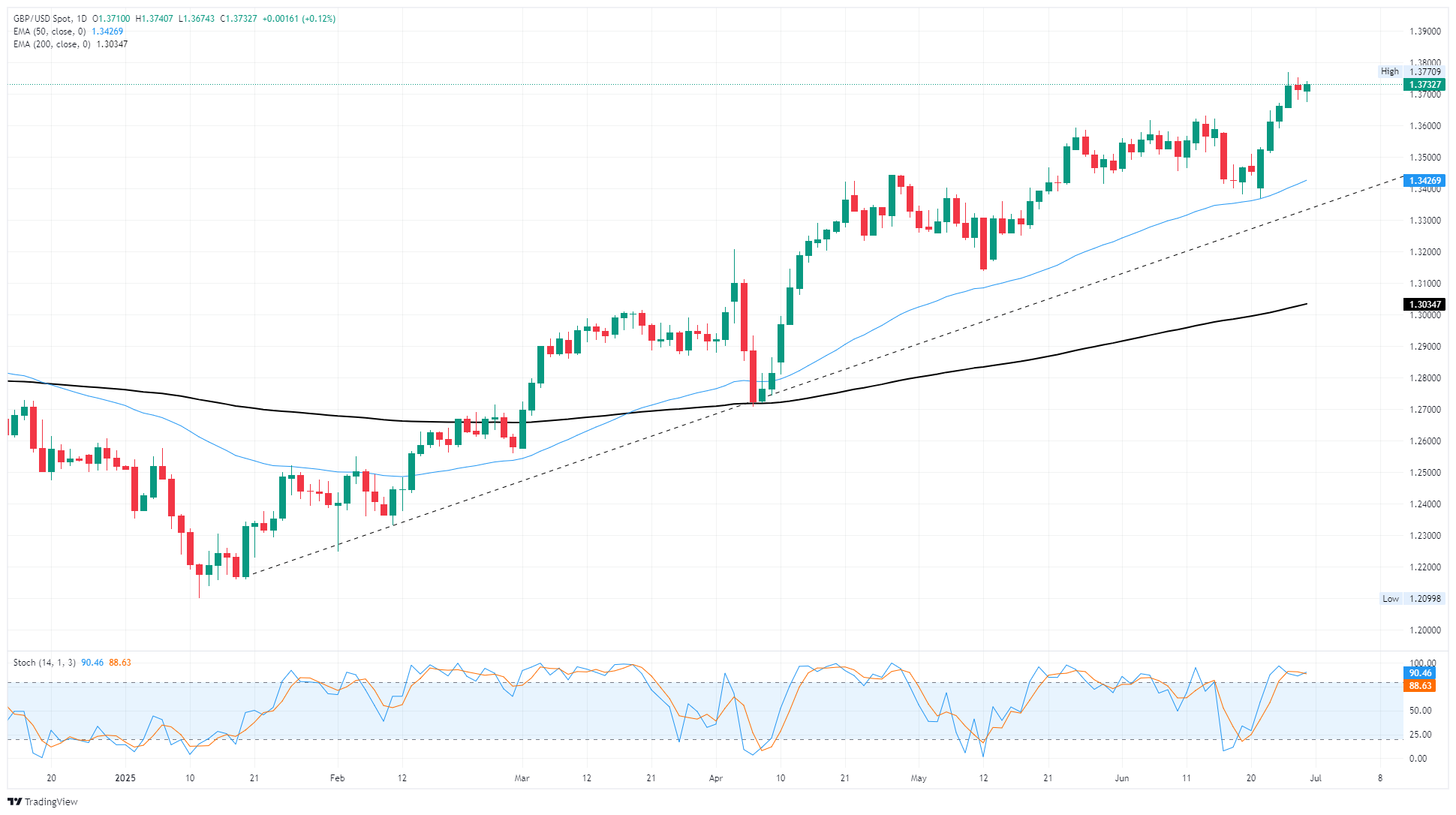GBP/USD holds onto high ground ahead of dual central bank appearances and US ISM data
- GBP/USD remains bolted firmly to multi-year highs above 1.3700.
- Despite middling UK economic data, the Pound Sterling is holding steady against the waffling Greenback.
- BoE Governor Bailey and Fed Chair Powell are both due to make an appearance early Tuesday.
GBP/USD continues to knock into multi-year highs above the 1.3700 handle, with the pair keeping afloat on thin intraday volumes on Monday. Greenback flows continue to tilt into the bearish side, keeping Cable price action on rails and limiting the downside.
UK economic data broadly failed to move the needle on Monday, and Cable traders will be pivoting to Tuesday’s double-header appearance from Bank of England (BoE) Andrew Bailey and Federal Reserve (Fed) Chair Jerome Powell. Both central bank heads will be participating in the European Central Bank’s (ECB) Forum on Central Banking 2025, which is being held in Sintra, Portugal.
Also coming up on Tuesday, US ISM Manufacturing Purchasing Managers Index (PMI)data for June will be released later in the day. Median market forecasts are expecting aggregated business sentiment survey results to tick upwards to 48.8 from 48.5. However, investors will be keeping an eye out for any unexpected drops in business expectations as the Trump administration's sweeping tariff policies, including a global 10% tariff on all goods being imported into the US, as well as an eye-watering 50% tariff on all steel and aluminum imports, begin to take chunks out of the US domestic economy.
GBP/USD price forecast
GBP/USD caught an extended ride into fresh 44-month highs last week, testing above 1.3770 for the first time since October of 2021. The pair is on pace to close in the green for a fifth straight month as the US Dollar broadly weakens across the board.
Cable bidders may be flying too close to the sun as GBP/USD prices quickly outrun rising trendlines, with price action trading well above the 200-day Exponential Moving Average (EMA) near 1.3020. Technical oscillators are pinned in overbought territory, warning of a potential pullback on the cards.
GBP/USD daily chart

Pound Sterling FAQs
The Pound Sterling (GBP) is the oldest currency in the world (886 AD) and the official currency of the United Kingdom. It is the fourth most traded unit for foreign exchange (FX) in the world, accounting for 12% of all transactions, averaging $630 billion a day, according to 2022 data. Its key trading pairs are GBP/USD, also known as ‘Cable’, which accounts for 11% of FX, GBP/JPY, or the ‘Dragon’ as it is known by traders (3%), and EUR/GBP (2%). The Pound Sterling is issued by the Bank of England (BoE).
The single most important factor influencing the value of the Pound Sterling is monetary policy decided by the Bank of England. The BoE bases its decisions on whether it has achieved its primary goal of “price stability” – a steady inflation rate of around 2%. Its primary tool for achieving this is the adjustment of interest rates. When inflation is too high, the BoE will try to rein it in by raising interest rates, making it more expensive for people and businesses to access credit. This is generally positive for GBP, as higher interest rates make the UK a more attractive place for global investors to park their money. When inflation falls too low it is a sign economic growth is slowing. In this scenario, the BoE will consider lowering interest rates to cheapen credit so businesses will borrow more to invest in growth-generating projects.
Data releases gauge the health of the economy and can impact the value of the Pound Sterling. Indicators such as GDP, Manufacturing and Services PMIs, and employment can all influence the direction of the GBP. A strong economy is good for Sterling. Not only does it attract more foreign investment but it may encourage the BoE to put up interest rates, which will directly strengthen GBP. Otherwise, if economic data is weak, the Pound Sterling is likely to fall.
Another significant data release for the Pound Sterling is the Trade Balance. This indicator measures the difference between what a country earns from its exports and what it spends on imports over a given period. If a country produces highly sought-after exports, its currency will benefit purely from the extra demand created from foreign buyers seeking to purchase these goods. Therefore, a positive net Trade Balance strengthens a currency and vice versa for a negative balance.

